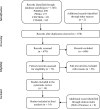Comparison of the effects of kilohertz- and low-frequency electric stimulations: A systematic review with meta-analysis
- PMID: 29689079
- PMCID: PMC5915276
- DOI: 10.1371/journal.pone.0195236
Comparison of the effects of kilohertz- and low-frequency electric stimulations: A systematic review with meta-analysis
Abstract
Objective: This study aimed to determine whether kilohertz-frequency alternating current (KFAC) is superior to low-frequency pulsed current (PC) in increasing muscle-evoked torque and lessening discomfort.
Data sources: The electronic databases PubMed, PEDro, CINAHL, and CENTRAL were searched for related articles, published before August 2017. Furthermore, citation search was performed on the original record using Web of Science.
Review methods: Randomized controlled trials, quasi-experimental studies, and within-subject repeated studies evaluating and comparing KFAC and PC treatments were included. The pooled standardized mean differences (SMDs) of KFAC and PC treatments, with 95% confidence intervals (CIs), were calculated using the random effects model.
Results: In total, 1148 potentially relevant articles were selected, of which 14 articles with within-subject repeated designs (271 participants, mean age: 26.4 years) met the inclusion criteria. KFAC did not significantly increase muscle-evoked torque, compared to PC (pooled SMD: -0.25; 95% CI: -0.53, 0.06; P = 0.120). KFAC had comparable discomfort compared to that experienced using PC (pooled SMD: -0.06; 95% CI: -0.50, 0.38; P = 0.800). These estimates of the effects had a high risk of bias, as assessed using the Downs and Black scale, and were highly heterogeneous studies.
Conclusions: This meta-analysis does not establish that KFAC is superior to PC in increasing muscle-evoked torque and lessening discomfort level. However, no strong conclusion could be drawn because of a high risk of bias and a large amount of heterogeneity. High quality studies comparing the efficacy between PC and KFAC treatments with consideration of potential confounders is warranted to facilitate the development of effective treatment.
Conflict of interest statement
Figures






References
-
- Jones S, Man WD, Gao W, Higginson IJ, Wilcock A, Maddocks M. Neuromuscular electrical stimulation for muscle weakness in adults with advanced disease. Cochrane Database Syst Rev. 2016;10:CD009419 Epub 2016/11/02. doi: 10.1002/14651858.CD009419.pub3 . - DOI - PMC - PubMed
-
- Maffiuletti NA. Physiological and methodological considerations for the use of neuromuscular electrical stimulation. Eur J Appl Physiol. 2010;110(2):223–34. Epub 2010/05/18. doi: 10.1007/s00421-010-1502-y . - DOI - PubMed
-
- Adams GR, Harris RT, Woodard D, Dudley GA. Mapping of electrical muscle stimulation using MRI. J Appl Physiol (1985). 1993;74(2):532–7. Epub 1993/02/01. doi: 10.1152/jappl.1993.74.2.532 . - DOI - PubMed
-
- Maffiuletti NA, Minetto MA, Farina D, Bottinelli R. Electrical stimulation for neuromuscular testing and training: state-of-the art and unresolved issues. Eur J Appl Physiol. 2011;111(10):2391–7. Epub 2011/08/26. doi: 10.1007/s00421-011-2133-7 . - DOI - PubMed
-
- Ward AR, Shkuratova N. Russian electrical stimulation: the early experiments. Physical therapy. 2002;82(10):1019–30. Epub 2002/09/28. . - PubMed
Publication types
MeSH terms
LinkOut - more resources
Full Text Sources
Other Literature Sources
Miscellaneous

